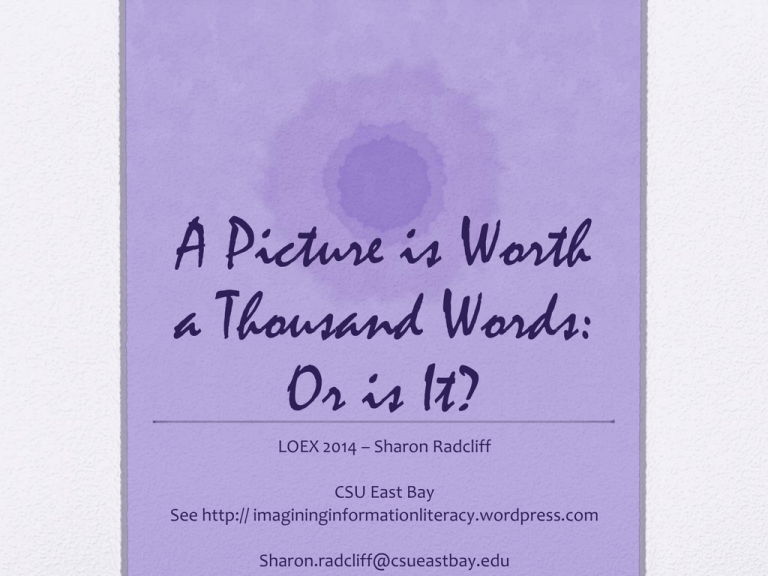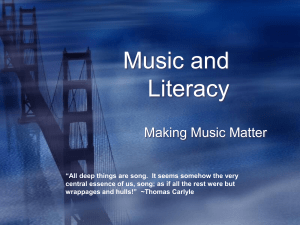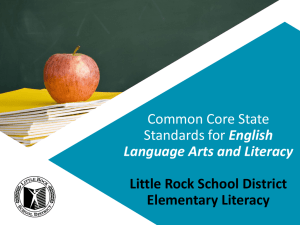
A Picture is Worth
a Thousand Words:
Or is It?
LOEX 2014 – Sharon Radcliff
CSU East Bay
See http:// imagininginformationliteracy.wordpress.com
Sharon.radcliff@csueastbay.edu
Using Images to Teach Visual &
Information Literacy
• Visual Literacy was founded as an academic
movement by Jack Debes of Kodak in the ‘60’s
with members of the University of Rochester;
they began the International Visual Literacy
Association
• To exchange ideas related to visual literacy
• ACRL Now has Visual Literacy Competencies
Some articles relating information
literacy to visual literacy & argument
•
Hattwig, D. , Bussert, K. Medaille, A., Burgesss, J. (2013). Visual Literacy Standards
in Higher Education: New opportunities for libraries and student learning. Portal:
Libraries and the Academy. 13 (1) 61-89.
•
Fleming, D. (1996) Can pictures be arguments? Argumentation & Advocacy 33(1), 1118
•
Ravas, T. & Stark, M. (2012) Pulitzer-prize-winning photographs and visual literacy
at the University of Montana: A case study. Journal of Art Libraries Society of North
America 31 (Spring). 34-44.
•
Birdswell D. S., Groarke, L. (2007). Outlines a Theory of Visual Argument.
Argumentation & Advocacy. 43(3-4). 103-108
•
Duggan, M. (2013) Photo and video sharing grow online: additional analysis. Pew
Research Center. http://www.pewinternet.org/2013/10/28/additional-analysis/
•
Two Books for
Inspiration
• Classic in the field of Visual Culture:
• John Berger’s Ways of Seeing
• Many excellent examples of how to use
images to teach writing (Many of these can be
adapted for information literacy):
• Kathleen Walsh-Piper’s Image to Word: Art and
Creative Writing
Why include images in
your instruction?
• Our current generation of students use: Pinterest,
Instagram, YouTube, Flickr, Facebook, Snapchat to
communicate their thoughts and ideas via images.
• According to a PEW Research report (Duggan, M.
2013) over 50% of all internet users post pictures
online and over 45% re-post them. Those numbers
go up to 81% and 61 % respectively for adults aged
18-29. To them, the image is as much (if not more)
a medium of communication as the word.
And…
My assignments in LIBY
1210:
• News photographs:
• Google image; image citing; background
research; alternative perspectives, visual
literacy; threshold concept: Research as Inquiry
& Format as Process; Scholarship as a
conversation
Advertisements:
Jib Fowles 15 appeals of advertising; identify
and check claims; analyze reliability of source
& credibility of author; threshold concept:
authority and contextualized and constructed
Context: 2-unit Information
Literacy Course
• Learning Objective: Students write a research
paper – 2 possible topics:
• Energy and the environment
• Person who made a difference: explore a key
issue, using alternative perspectives
In groups do a final presentation using visual
images and spoken word (Pecha Kucha)
Teaching goal: Integrate argument and images
into information literacy
Visual assignments:
• Photographs: Alternative perspectives, copyright,
researching an issue using Web and library sources
• Advertisements: Explore authority, advertising
appeals, audience in ads and writing
• Political cartoons: Bias, point of view, research an
issue
• Infographics: Explore data telling a story,
alternative perspectives, authority, create an
infographic.
Using Photos to Teach Alternative
Perspectives and Research
• Students work in groups to identify a photo in
Google image
• Two versions:
• Historical and news photos
• Energy and environment photos
• Research the photo’s context on the Web and
using library resources (eg Lexis Nexis;
Academic Search Premier)
Find a photo representing an alternative
perspective -- student example:
Another Example
Tank Man
Three Mile Island
Students answer critical questions
about photographs
• Cite Photographs in MLA or APA
• Discuss copyright; ethical use of information
• Present in groups the photograph pairs to the
class
• Homework: find, cite and analyze an image
relating to their research paper topic.
Photograph Homework
• Find an image related to their research topic
• Answer critical questions about it
• Some resources for more in depth critical
questioning:
• http://twp.duke.edu/uploads/assets/photograp
hy.pdf
• http://www.iste.org/docs/excerpts/MEDLITexcerpt.pdf
• http://www.learnnc.org/lp/pages/675
Advertisement
Exercise
• Each student is given an advertisement
• Alternative method: show a few ads; have
students find their own.
• Examples: Sports drinks; nutritional
supplements; health foods
• In groups, student choose on ad to focus on
• Students analyze ads using Jib Fowles 15
appeals of advertising
• Students identify claims and check them in
library sources and report out to class.
Advertisements can appeal to:
• Excerpt from Common Culture: Reading and Writing About
American Popular Culture.
• 1 The need for sex
2. The need for affiliation
3~ The need to nurture
4. The need for guidance
5. The need to aggress
6. The need to achieve
7. The need to dominate
8. The need for prominence
9. The need for attention
10. The need for autonomy
11. The need to escape
12. The need to feel safe
13. The need for aesthetic sensations
14. The need to satisfy curiosity
15. Physiological needs: food, drink, sleep, etc.
• http://www.cyberpat.com/shirlsite/education/essay2/jfowles.html
Advertising Cont.
• Students identify claims and check them in
library sources.
• Students evaluate their source using criteria
identifying characteristics of popular, trade,
academic sources.
• Students examine sources for credibility,
reliability, timeliness, relevance.
• Students report out to class.
Your turn: For photos
• Option One: Download a photo from:
• https://imagininginformationliteracy.wordpress.
com
• Option two: Use photographs in packet
• All: Answer questions in packet
• One or two groups present briefly to the
group
Your turn: For ads
• View your ads in your group
• Answer questions in packet
• One-two groups report out.
In your groups
• Brainstorm ideas for integrating images and
visual literacy into your information literacy
instruction
• Possibilities: GIS, Photographs, infographics,
• advertising, or ?
• Full group discussion
End
• Questions or suggestions
• E-mail Sharon Radcliff
• Sharon.radcliff@csueastbay.edu







